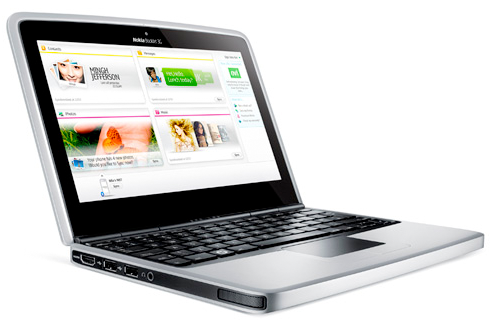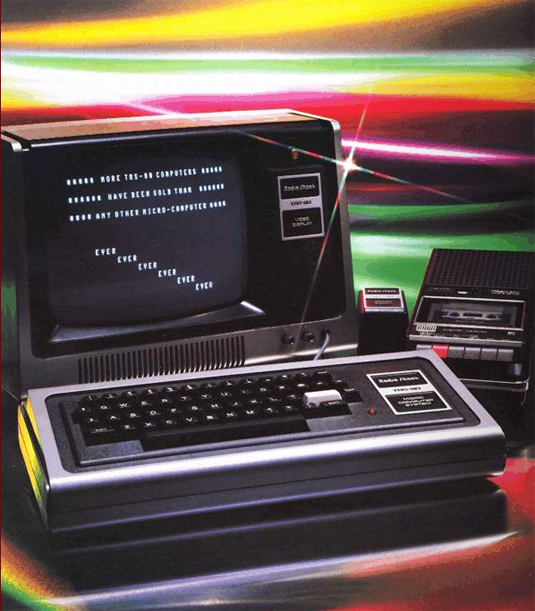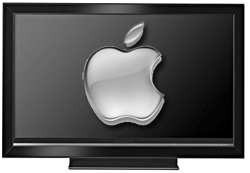Like 5Words? Subscribe via RSS.
Finnish guy legally unlocks iPhone.
Like 5Words? Subscribe via RSS.
Finnish guy legally unlocks iPhone.
Nokia, which has made some PC-like devices in its day, is finally making…a PC. The company has announced the Booklet 3G, a device that it’s calling a mini-laptop. I’m calling it a netbook, but a pretty fancy one: It’s got an aluminum case, built-in 3G (with swappable SIM card) and GPS, and HDMI output. Nokia claims twelve hours of battery life–even if you apply the usual discount and assume it’ll be more like eight hours in the real world, it would be impressive. It features Nokia’s Ovi services for synchronization with the company’s phones. It weighs 2.75 pounds and is “slightly more than two centimeters thin,” which would make it a bit under .8″. Oh, and the Booklet runs Windows–and Windows 7 at that.
Judging from the photos, the Booklet’s industrial design gives us a good idea of what an Apple netbook might look like if it was a MacBook Pro, only smaller:

Here’s Nokia’s promotional video:
I’m a sucker for the concept of deluxe netbooks, so I’m glad that the Booklet is joining HP’s Mini 5101 at the high end of the market. Nokia hasn’t announced a price, but if all the stuff it’s talking about comes standard, I wouldn’t be shocked if the system cost in the neighborhood of $800 or even a bit more, assuming it’s not subsidized by a wireless carrier. (Which, for netbooks, is a pretty darn exclusive neighborhood.) It also hasn’t said anything about availability yet–and it’s not a given that this beast will be widely available in the U.S., given the company’s relatively low profile in the states. It says it’ll have more to say about the Booklet at its Nokia World conference on September 2nd.
 Rumors that Apple might beat its self-imposed September deadline to ship its OS X 10.6 Snow Leopard operating system were true: It’s now official that the upgrade will show up for sale this Friday, August 28th. The date is nowhere near as big a deal for Apple aficionados as October 22nd, Windows 7’s release date, will be for the Windows-using majority. But I’m still looking forward to trying Snow Leopard, and to hearing what Mac users think about it.
Rumors that Apple might beat its self-imposed September deadline to ship its OS X 10.6 Snow Leopard operating system were true: It’s now official that the upgrade will show up for sale this Friday, August 28th. The date is nowhere near as big a deal for Apple aficionados as October 22nd, Windows 7’s release date, will be for the Windows-using majority. But I’m still looking forward to trying Snow Leopard, and to hearing what Mac users think about it.
Unlike Windows 7, Snow Leopard has virtually nothing in the way of significant new features, with the exception for Exchange support in its Mail, iCal, and Address Book apps. Instead, Apple has done major renovation below the surface to make the OS faster, more powerful, and more robust–it’s rewritten various pieces of code to make them faster and added 64-bit versions of bundled applications, for instance. In theory, at least, it all makes Snow Leopard a noticeably more agile breed of cat than its predecessor. But it also makes the upgrade a more complicated proposition than typical new OSes with lots of new features. (OS X 10.5’s Time Machine, for instance, was a really tangible reason to get Leopard.)
Ultimately, if Snow Leopard feels strikingly quicker and more reliable than Leopard, it will be well worth the $29 upgrade price ($49 for five users). In my experience, Macs are less prone to problems than Windows machines, but they’re still far from bulletproof: They get bogged down, misbehave, and suffer crashes just as deadly as Blue Screens of Death. I kind of admire Apple for trying to sell an upgrade that’s mostly about making the OS do what it’s supposed to do more reliably, and wouldn’t object if the next version of Windows were something along the lines of, um, Windows Snow 7. (Windows 7, like Snow Leopard, is mostly about unglamorous-but-useful enhancements, but most of them are interface tweaks; under the hood, it’s not a massive overhaul of Vista.)
Looking over Apple’s list of Snow Leopard improvements, I see that one that it mentions at some length is remarkably mundane: Snow Leopard ejects optical discs more reliably than its predecessors. I’ve spent a lot of time over the years trying to cajole CDs and DVDs to come out of Macs; if Snow Leopard removes that hassle it, would make my life meaningfully better in a way that Leopard’s flashier Spaces desktop manager, say, has not.
Let’s end this with today’s T-Poll:
 I’ve drizzled various beverages into notebook keyboards. I’ve released laptops from my hands and watched as they’ve struck carpet, hardwood, and concrete. I’ve broken connectors with a definitive “snap.” I wish I could say it was part of some methodical lab testing, but I’ve done all of the above and more during the continuous tech stress test known as everyday living.
I’ve drizzled various beverages into notebook keyboards. I’ve released laptops from my hands and watched as they’ve struck carpet, hardwood, and concrete. I’ve broken connectors with a definitive “snap.” I wish I could say it was part of some methodical lab testing, but I’ve done all of the above and more during the continuous tech stress test known as everyday living.
In my newest guest post for WePC.com, “The Ultimate Laptop Torture Test: Real Life!,” I write about some of the ways notebooks get broken, and what manufacturers can do to toughen them up against the abuse we inflict. If you check out the post, leave a comment with your horror stories about laptop damage and/or ideas for stopping it. (Here’s an incentive to contribute: WePC is giving away dozens of Asus notebooks, netbooks, and gaming PCs–both to folks who contribute the smartest comments, and in random drawings.)
See you over there, I hope…
 RealNetworks’ Rhapsody is a very nicely done music service. But like all subscription music offerings it’s been profoundly hobbled by the fact that it’s incompatible with iPods, the devices that dominate portable digital music. That’s about to change. Sort of. Maybe.
RealNetworks’ Rhapsody is a very nicely done music service. But like all subscription music offerings it’s been profoundly hobbled by the fact that it’s incompatible with iPods, the devices that dominate portable digital music. That’s about to change. Sort of. Maybe.
Over at its corporate blog, RealNetworks its reporting that it’s submitted a Rhapsody application to the iPhone App Store. The app would bring Rhapsody to the iPhone and iPod Touch, letting owners of those devices pay a monthly fee ($14.99, apparently–the price of a Rhapsody to Go account) for unlimited access to the millions of tracks in Real’s catalog.
Here’s a video from Real showing the app in action:
[vodpod id=Groupvideo.3266941&w=425&h=350&fv=]
Rhapsody for iPhone is missing one key feature offered by Rhapsody to Go on other devices: It can stream music (over both 3G and Wi-Fi) but can’t store it locally. That means it only works when you have an Internet connection. Real says it may add local music storage later, and that an upcoming Android version of Rhapsody will store music locally.
 The great silence is over. Apple has responded to the FCC’s questions about the Google Voice app in particular and the iPhone App Store in general–and it not only sent its answers to the feds, but published them on the Web. It’s the first time the company has talked about App Store procedures and processes in public. And Engadget has posted the letters Google and AT&T sent to the FCC. All of a sudden, we know way more about what’s been going on behind the scenes.
The great silence is over. Apple has responded to the FCC’s questions about the Google Voice app in particular and the iPhone App Store in general–and it not only sent its answers to the feds, but published them on the Web. It’s the first time the company has talked about App Store procedures and processes in public. And Engadget has posted the letters Google and AT&T sent to the FCC. All of a sudden, we know way more about what’s been going on behind the scenes.
Some of the tidbits in the three letters reconfirm stuff that was already known, such as Sling’s SlingPlayer being crippled because of concerns over network congestion in general and violation of AT&T’s terms of service in specific. Others make the obvious official, such as AT&T’s statement that it does not like the idea of VoIP services such as Skype running over its 3G network. Apple’s statement emphasizes the good news about App Store approval–95% of apps get the okay within two weeks–and stresses that most rejections are because of bugs. It also says that the App Store gets 8500 new apps and updates a week, that there are more than 40 full-time reviewers, and that every app is checked by two reviewers. Assuming that the average reviewer puts in a ten hour workday (not including lunch) that would mean that he or she must crank through around eight apps an hour–which means that the average inspection must be profoundly superficial, and that most must involve snap judgements that may be prone to error. (We kind of knew that already.)
In slightly under five hours, I’ll end our giveaway of a 500GB Seagate FreeAgent Go portable hard drive. If you want a chance to win it, head to this post and share your memories, fantasies, or current stories relating to gadgets that make going to school more productive and/or fun.
Asus produces such a surging sea of variations on its Eee PC netbook–including computers that aren’t netbooks–that it’s hard to keep track of them all. So I don’t blame myself for somehow missing one that was demoed back at CES in January: the Eee Keyboard, which packs a computer inside a slim-looking keyboard. (Specswise, it’s essentially a laptop without a screen.)
The Eee Keyboard has a touchscreen to the right of the keys and HDMI output, and DigiTimes is reporting that it’ll be out “as early as October” for $400-$500. Here’s a video demo by UMPC Portal, shot at the CeBIT show in Germany:
I’m not so sure about that touch-screen, which looks a trifle weird, period, and possibly unusable for southpaws like me. But an Eee PC hooked up to a TV as a sort of giant remote control has potential. One of the reasons I still don’t have a TV in my living room is that I’ve never seen one I’d want to put in my entertainment center. But with this computer, there’s nothing to put anywhere but in your lap.
And hey, I’m not ashamed to admit that I find the Eee Keyboard intriguing in part because the very first computer I used was also a PC-in-a-keyboard. (No, that’s not a touchscreen to the right of the keys–it’s a big ol’ TRS-80 logo.)

(TRS-80 image borrowed from Radio Shack Catalogs.)
Like 5Words? Subscribe via RSS.
Twitter to add location awareness.
Tweeting from within Facebook pages.
Snow Leopard: Late August? September?
Windows 7 touch PCs: plentiful?
 Does Apple want to get into the TV business? There’s no concrete evidence that it does, but analyst Gene Munster sure thinks it makes sense. Back in February he said he expected the company to make TVs with built-in DVRs. And now he’s raised the idea up the flagpole again. Fortune’s Philip Elmer-DeWitt has written about Munster’s scenario involving Apple making HDTVs and next-generation Apple TV-type functionality–including an subscription-based iTunes service designed to compete with Hulu, Netflix Watch Instantly, and even Comcast. In Munster’s speculative rollout, this happens by 2011.
Does Apple want to get into the TV business? There’s no concrete evidence that it does, but analyst Gene Munster sure thinks it makes sense. Back in February he said he expected the company to make TVs with built-in DVRs. And now he’s raised the idea up the flagpole again. Fortune’s Philip Elmer-DeWitt has written about Munster’s scenario involving Apple making HDTVs and next-generation Apple TV-type functionality–including an subscription-based iTunes service designed to compete with Hulu, Netflix Watch Instantly, and even Comcast. In Munster’s speculative rollout, this happens by 2011.
T-Poll time:
